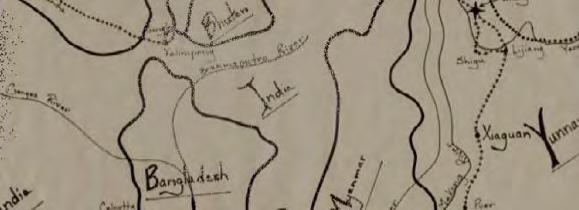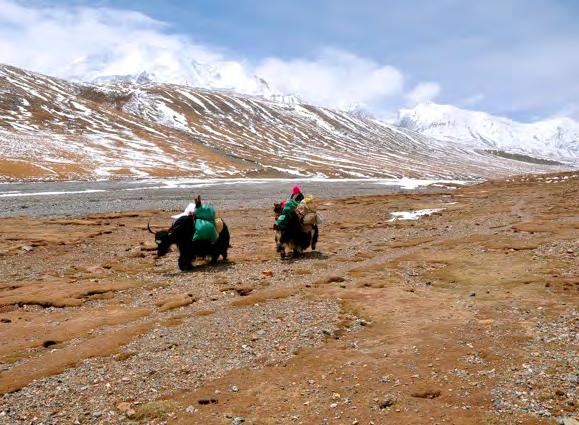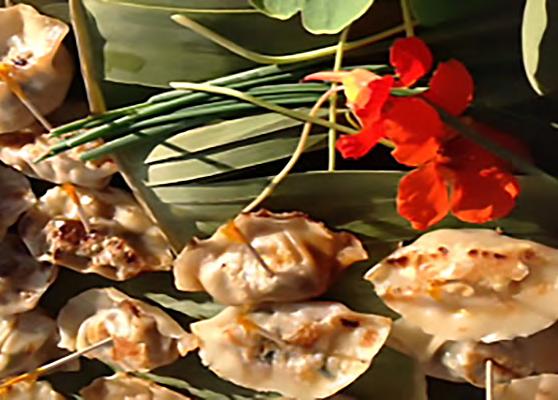
1 minute read
Travels on the Tea Salt Road -Tibet China
by Jeff Fuchs
Words At 4,200 metres
Advertisement


Kersang the Wise poses in her home near Amne Machin.
Jeff Fuchs
Amne Machin sits like a massive even by nomadic standards and when knife of rock rising out of one of winters do come to these lands, “even the highest altiplano’s on earth, the the wolves leave” according to locals. Qinghai-Tibet Plateau. A pathway that It is one of the coldest regions within is centuries old and marked with the the Himalayan realm. memories of pilgrims, traders, and the desperate rings of the great mountain's outer borders. North of the grand who have only 6000 + metre peaks, recently ‘moved within the shadows, up’ in the world I’m tucked into a (though this ramshackle little hut along this pathway in a village that is strewn together collection of huts, motorbikes and a general store.
My presence here on my way around the sacred mountain site is unexpected but taken in stride and treated as nothing more than a welcome extra body to feed, listen to, study a little, and of course offer up a bed to. Here, all living things must cooperate or perish. As part of a journey to trace and document an ancient and little documented nomadic trade route, I’ve arrived here. It has been a touch over a month since this journey began. The route itself is a tale of the ‘white gold of the mountains’, salt. To the local Tibetans it has long been simply known as the ‘Tsa’lam’ (literally ‘salt road’).
These women before me with their calluses, smiles, and sun-scarred faces are part of the landscape, and by extension a living part of the history of the region. The eldest of the women, has for the past hour been recounting her own memories of the route, and with it, a history that is both personal and vital. In this region - where oral narratives serve as textbooks, and close proximity to community and the relentless environments serve as teachers - words and their recounting have long been a form of documentation and of bonding. Words are listened to still and elders are revered, not for simply being ‘old’ but for having survived intact in one of the most daunting environments on the planet.
“Caravans came by to pay respects to the mountains and deities on their way to and from the salt lakes”, the eldest tells us. Her eyes still glow with energy and vitality and her name - she tells me – is Kersang. She is uncertain of her exact age, because as she reminds me, in those times births were not always marked into a calendar as we know it. She does, after some time, let me know that she thinks she is 67 years old.

Kersang in her precious wools, corals, and turquoise.
Jeff Fuchs
Her daughter, Chu’pi, with hair braids running down her back is a blur of movement within the small quarters. Bowls are lined up on the stove and a froth of butter, stewed tea, salt and a little barley powder is sloshed in. Steaming, thick and frothy, the liquid itself is a testament to an unchanged ‘culinary’ tradition. Tea in this remote home is what it always has been: an introduction, a welcome to speak, rest, be heard, and take in calories. To not be offered tea in such a home would be the equivalent of telling someone that they are not welcome.
Taking back a bowl of tea, Kersang continues her talk of a world of splendid isolation and grit…and the route animated. It is perhaps too, the tea kicking in with its eternal stimulant abilities.

Kersang's home, which was at times, like a repository of tea, butter and wools.
Jeff Fuchs
In this small space, Kersang is the equivalent for me of an alchemist or magician. When she speaks it is slow and her eyes twinkle the light of all she has seen. Her hands remain folded in her lap, once in a while spreading wide as she speaks. She often refers back to the words, “the land”. Upon the Tibetan plateau, the land and its people are inextricably linked and bound. People may hold grudges but they also bear a shared struggle to simply survive. Trade, though, seems a Kersang in her precious wools, corals, and turquoise. favorite topic for Kersang. “Our lives were about our herds and we could trade easily for salt. For these “The nomads (ngdrog’ba) would Khampas (Tibetans of the east) they come with their yak caravans from had to travel distances to source the Ganzi, Serthar, Baima (in Sichuan to ‘white gold. They had to travel disthe southeast) and bring pine resin tances to find anything to trade”. She is to trade for the salt. Salt…and tea, warming to the memories of the days of were everything”. trade, and her hands have become more animated. It is perhaps too, the tea kicking in with its eternal stimulant abilities. Around us, late afternoon winds hint that the mountain version of night “Our lives were about our herds and we could trade easily for salt. For these Khampas (Tibetans of the east) they had to travel distances to source the ‘white gold. They had to travel distances to find anything to trade”. She is warming to the memories of the days of trade, and her hands have become more connection to each other create a luxury of space and feel. Light fades slightly and preparations begin to make dinner, and of course take a bit more tea. Kersang is glowing, is not far off. Kersang’s still smooth skin creases briefly as she smiles at something her daughter has said. This little home, with its cracks for the wind to prod, and its smell of smoke and butter is as comfortable a space as I’ve been in a long while. The human dynamic and the perhaps in rekindled memories of a forgotten trade route, or perhaps simply because she understands her place better than most.

Braided pleats of hair tied into ornaments is common within the nomadic communities.
Jeff Fuchs

Jeff ’s journey along the route of Salt, the Tsa’lam.
Jeff Fuchs explorer / author
www.jefffuchs.com
Having lived for most of the past decade in Asia, Fuchs’ work has centered on indigenous mountain cultures, oral histories with an obsessive interest in tea. His photos and stories have appeared in World Geographic, Kyoto Journal, The Spanish Expedition Society, The Earth, The China Post Newspaper , Silkwinds , Outpost, The Toronto Star, and The South China Morning Post amongst others.

HIMALAYAN TEA DUMPLINGS & LAMB SAUCE HIMALAYAN TEA DUMPLINGS & TOMATO SAUCE semi-oxidized Yunnan tea dumplings, leeks, lamb sauce, five spice, tomatoes, yogurt, garlic
by Carol Mark, tea sommelier & chef

Dumplings


Showcasing my dumplings

The Chinese have a long history of dumplings, and growing up I have memories of the soft dough between my teeth squishing out warm sweet meat fillings scented with spices. This is my version inspired by a humanitarian aid trip to Afghanistan. You can use ready made wonton wrappers.
serves 4
Lamb Sauce
1 lb. ground fresh lamb
1 tsp smoked paprika
1 T allspice
4 cardamom ground
5 cloves
1 T turmeric
1 T chili powder
1 T cumin
3 knobs ginger, peeled and diced
2 cloves garlic minced
1 stick cinnamon
3 T grenadine syrup
2 C crushed tomatoes
1 C water vegetable oil
PREPARATION: Lamb sauce can be made ahead and reheated.
1)Heat oil in pan until hot adding spices until fragrant watching it does not burn. Add lamb to brown.
2)Add tomatoes and water and simmer 30 mins on low. Stir often as it burns easily.
Vegetarian Himalayan Tea Dumplings kidney beans, tomatoes, smoked paprika, cilantro serves 4
2 C canned white kidney beans, drained 10 seeded, chopped fresh tomatoes or tinned 2 garlic cloves, minced 1 tsp chili powder 1 tsp smoked paprika 1 tsp salt 4 T olive oil cilantro
1)In a pan with olive oil, saute garlic until fragrant on medium high, add chili powder and smoked paprika, watching not to be burn until just mixed.
2) Add tomatoes and kidney beans cook on low for 30 minutes. Last minutes check that most liquid has been absorbed and not runny. Season to taste and garnish with fresh cilantro.
3) Substitute this vegetarian version topping for the lamb.
Dumpling Filling
3 leeks washed and cleaned with white parts cut in slices
4 stalks green onions chopped or 1 C chives chopped
3 T semi-oxidized Yunnan tea or semi-oxidized tea such as oolong infused in 2 C boiling water drain keeping tea leaves and tea separate; mince tea leaves and set aside.
1/2 tsp salt
4 T vegetable oil
1) In a pan on medium heat stir fry leeks, green onions cooking on low once transparent with lid off. Stir often.
2) Add few tablespoons of prepared tea if dry.
3) Cook approximately 15 mins. Add chopped tea leaves and mix well.
Tea Sommelier’s Tip: Rinse the tea leaves initially before infusing to open up the leaf. Teas can have multiple infusions starting with 1 minute and increasing steeping time each steep. This recipe we utilize only one steep.
Dumpling Dough
1 1/2 C all-purpose flour
4 T semolina flour (prevents over stickiness)
1/2 C hot water
PREPARATION:
1) Place flour in bowl and pour water slowly and stir with a fork.
2) When cool place on floured table and knead about 6 times until firm.
3) Place back in bowl covering with a damp cloth to stand for 20 minutes.
4) Place dough on lightly floured surface and knead 5 more minutes and roll into a roll about 1 1/2 inches diameter. Cut in half and cut out 12 pieces in each roll
to total approximately 24.

Bring the dumpling corners together

5) Press each circle with palm of hand and using rolling pin roll each piece from the centre outwards turning a quarter each time and keeping round shape. The edges should be thinner than the centre.Dust lightly with flour and pile under damp dry cloth.
6) Assemble dumpling place 1 tsp of leek tea filling in centre, moisten edges with water, fold in half moon and seal along edge. Bring ends together and pinch. Extra dumplings can be frozen.
Yoghurt
2 C Greek style heavy yoghurt
2 garlic cloves
minced 4 T mint, chopped
PREPARATION:
1) Using the tea from tea from the tea infusion boil and drop in dumplings not crowding until they float to top about 6 mins. If not enough liquid add extra water. Drain well. To prevent sticking use 1 tsp oil to toss.

Enjoy!
2) Assemble by layering the dumplings, meat mixture, and yogurt. Top with extra chopped herbs such as cilantro or mint.
© Carol Mark all rights reserved theloveofteamag
Tea Sommelier’s Tip: Using the tea to boil the dumplings further deepen’s the tea taste. Dumplings have a history dating back to the tea traders and Alexandra the Great with variations that marked his route.







